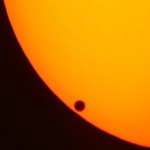
We will be webcasting the transit live from the Keck telescopes at the summit of Mauna Kea. Tune in for images of the transit, and a lot of information about the transit. Larry O’Hanlon and I will be talking about the transit, the science, the history, and just generally enjoying the experience. You are invited to join us. Expect the broadcast to start about 11:45HST, or about 25 minutes before first contact.
Want to see for yourself? There are multiple locations around the island where you will find solar telescopes and volunteer guides to answer your questions about this event. Not on the Big Island? Check you local paper or look up your local astronomy club to find public events. Science museums, colleges, astronomy clubs and other astronomy organizations are organizing public events wherever the transit can be seen.
| Location Name | External Sun Ingress Alt h m s ° |
Internal Sun Ingress Alt h m s ° |
Greatest Sun Transit Alt h m s ° |
Internal Sun Egress Alt h m s ° |
External Sun Egress Alt h m s ° |
| Anchorage, AK | 14:06:30 51 | 14:24:04 51 | 17:26:53 38 | 20:30:46 16 | 20:48:32 14 |
| Honolulu, HI | 12:10:07 85 | 12:27:46 89 | 15:26:20 49 | 18:26:38 9 | 18:44:38 5 |
| Kona, HI | 12:10:09 86 | 12:27:48 87 | 15:26:16 47 | 18:26:33 7 | 18:44:33 3 |
| Los Angeles, CA | 15:06:26 58 | 15:24:02 55 | 18:25:33 18 | — – | — – |
| Phoenix, AZ | 15:06:03 54 | 15:23:40 50 | 18:25:32 13 | — – | — – |
| Portland, OR | 15:06:05 57 | 15:23:40 54 | 18:25:53 23 | — – | — – |
| San Francisco, CA | 15:06:29 61 | 15:24:04 57 | 18:25:39 22 | — – | — – |
| Seattle, WA | 15:05:58 56 | 15:23:32 53 | 18:25:57 23 | — – | — – |
All times local. The data is taken from Fred Espenak’s NASA Eclipse Website. I extracted the cities that are of most interest to my Hawaiian readers. For the full list of US cities you can go here.
Please exercise caution when viewing the Sun! Use appropriate eye protection or indirect observing techniques to project an image of the Sun. The link at the start of this paragraph leads to a great discussion on viewing the Sun safely. As always the single best source on the web (or anywhere) for eclipse and transit information is Fred Espenak’s eclipse website at NASA. Stop by whenever you have a question on upcoming events as well as viewing and photography tips.

